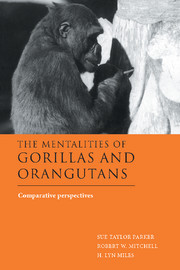Book contents
- Frontmatter
- Contents
- List of contributors
- Preface
- Acknowledgments
- I Comparative evolutionary and developmental perspectives on gorillas and orangutans
- 1 Hominid family values: morphological and molecular data on relations among the great apes and humans
- 2 The life history and development of great apes in comparative perspective
- 3 The frontal lobes of the great apes with a focus on the gorilla and the orangutan
- II Cognition and tool use in gorillas and orangutans
- III Communication in gorillas and orangutans
- IV Social cognition in gorillas and orangutans
- V Epilogue
- Index of authors
- Index of subjects
1 - Hominid family values: morphological and molecular data on relations among the great apes and humans
Published online by Cambridge University Press: 20 October 2009
- Frontmatter
- Contents
- List of contributors
- Preface
- Acknowledgments
- I Comparative evolutionary and developmental perspectives on gorillas and orangutans
- 1 Hominid family values: morphological and molecular data on relations among the great apes and humans
- 2 The life history and development of great apes in comparative perspective
- 3 The frontal lobes of the great apes with a focus on the gorilla and the orangutan
- II Cognition and tool use in gorillas and orangutans
- III Communication in gorillas and orangutans
- IV Social cognition in gorillas and orangutans
- V Epilogue
- Index of authors
- Index of subjects
Summary
“What we've got here is, failure to communicate.”
(Cool Hand Luke. Warner Bros., 1967)INTRODUCTION
Recent fossil discoveries, methodological advances, and ongoing analyses of hominoid comparative molecular biology and morphology have led to dramatic changes in our current understanding of relations among the great apes and humans. The late nineteenth-century view of these relations held that humans and the African apes were most closely related, and that the Asian great ape, the orangutan, was a more distant relative (Darwin, 1871; Huxley, 1959). For most of the twentieth century however, the great apes have been placed not only in their own family (the Pongidae), but also in their own separate evolving lineage, to the exclusion of humans. In the past thirty years, a few molecular biologists have been questioning the evolutionary reality of the pongid lineage, suggesting a return to the Darwin–Huxley view, placing African apes closer to humans, but based on the results of comparative molecular biology. During that time, the techniques of molecular systematics have been greatly improved and refined, to the point where researchers are today actually comparing nucleotide sequences, the fundamental, specific arrangement of DNA molecules, as opposed to overall DNA similarity (hybridization) or the products of DNA metabolism (proteins).
This work in molecular biology has been joined by recent developments in method and theory in palaeontology and comparative anatomy. Foremost among these is the widespread adoption of cladistic methodology, but other developments include more comprehensive analysis of hominoid comparative anatomy, and a more complete hominoid fossil record.
- Type
- Chapter
- Information
- The Mentalities of Gorillas and OrangutansComparative Perspectives, pp. 3 - 42Publisher: Cambridge University PressPrint publication year: 1999
- 6
- Cited by



